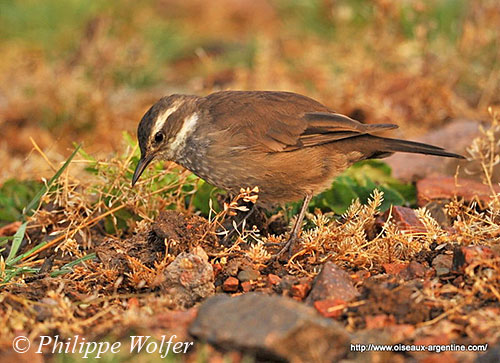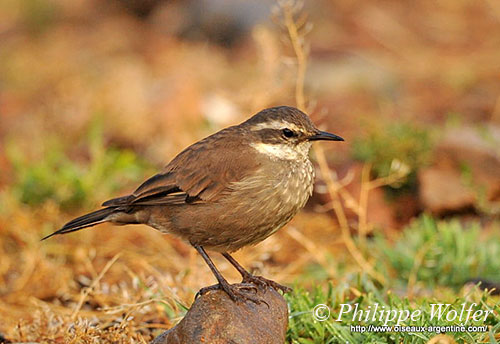
Fr: Cinclode d'Oustalet
Ang: Grey-flanked Cinclodes
All: Grauflanken-Uferwipper
Esp: Remolinera Chica
Ita: Cinclode fianchigrigi
Nd: Grijsflankwipstaart
Sd: gråsidig cinklod
Photographers:
John Anderson
John Anderson Photo Galleries
Philippe et Aline Wolfer
GALERIE
Text by Nicole Bouglouan
Sources:
HANDBOOK OF THE BIRDS OF THE WORLD Vol 8 By Josep del Hoyo-Andrew Elliott-David Christie - Lynx Edicions - ISBN: 8487334504
BIRDS OF SOUTH AMERICA – Passerines - by Robert S. Ridgely and Guy Tudor – HELM Field Guides – ISBN: 9781408113424
First Description of Nesting Ecology of the Endemic Grey-Flanked Cinclodes Cinclodes oustaleti baeckstroemii from the Juan Fernández Islands, Chile
Bioacoustic Characteristics and Population Numbers of Endemie Cinclodes oustaleti baeckstroemü (A\es: Furnariidae) Lönnberg, 1921 of Alejandro Selkirk Island, Chile
FICHA DE ESPECIE CLASIFICADA - Cinclodes oustaleti baeckstroemii
Sistema de Información de Biodiversidad de la Administración de Parques Nacionales, Argentina
Remolinera chica (Cinclodes oustaleti)
Wikipedia, la enciclopedia libre
Wikipedia, the free encyclopaedia
Grey-flanked Cinclodes
Cinclodes oustaleti
Passeriformes Order – Furnariidae Family
INTRODUCTION:
The Grey-flanked Cinclodes is found in C and S Chile and adjacent areas of Argentina, S to the Strait of Magellan. Three subspecies share the range.
The Grey-flanked Cinclodes frequents open grassy and rocky landscapes, and it is often seen near streams in mountains, up to 4,000 metres of elevation. It feeds on arthropods and several species of invertebrates.
This species is monogamous. It nests in an excavated burrow in earth bank or in rock crevice, often near a stream.
The generic name “Cinclodes” derives from the genus “Cinclus” (Family Cinclidae), indicating a resemblance to dippers that live at the water’s edge.
The name of the species “oustaleti” pays tribute to the French zoologist Jean Frédéric Emile Oustalet (1844-1905). The Grey-flanked Cinclodes was first described by the American ornithologist William Earl Dodge Scott in 1900, under the same scientific name. It was dedicated to Emile Oustalet.
The Grey-flanked Cinclodes is affected by degradation of the habitat, but the species is not globally threatened at the moment.

DESCRIPTION OF THE BIRD:
Biometrics:
Length: 17-18 cm
Weight: 22-31 g
The Grey-flanked Cinclodes of nominate race has dark brown upperparts including the upperwing, but the bend of the wing is whitish, the primary coverts are blackish-brown and we can see some rufous at base of the flight-feathers, forming a pale wingbar well visible on the open wing.
On the underparts, both throat and malar area are whitish with dark streaking. The breast is dull dark grey-brown with pale spots on the upper breast. These markings are less conspicuous on the lower breast, becoming short and faint streaks. The belly is paler and browner with whitish centre. Flanks and undertail-coverts are dark brown with some whitish feather tips.
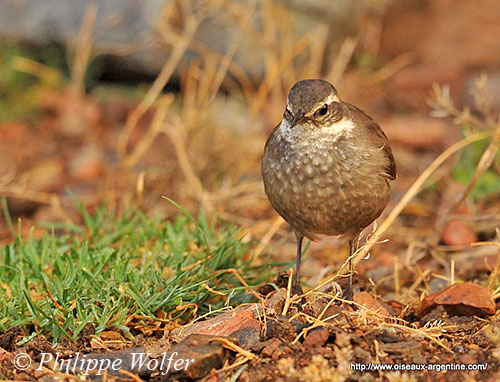
On the head, the crown is dark greyish-brown. We can see a conspicuous buff supercilium, speckled at front. Loral area and ear-coverts are blackish-brown.
The slightly decurved, medium-sized bill is blackish or blackish-horn. The eyes are dark brown. Legs and feet are blackish-brown.
Male and female are similar.
The juvenile is not described.
SUBSPECIES AND RANGE:
The Grey-flanked Cinclodes has three subspecies.
C.o. oustaleti (described above) is found in C and S Chile and adjacent W Argentina, and also on Chiloé Island.
C.o. baeckstroemii occurs on Alejandro Selkirk Island in Juan Fernández Islands off Chile.
This race shows rufous tinge on body sides, flanks and undertail-coverts.
C.o. hornensis is found on Desolación Island (S Chile), Tierra del Fuego and Cape Horn. Some individuals move N to S Argentina and C Chile.
This one has darker grey upperparts, but much duller than nominate. The underparts are greyer and less brown, especially on flanks.
HABITAT:
The Grey-flanked Cinclodes inhabits open grassy and rocky habitats. It is visible from sea-level to 4,000/4,200 metres of elevation. This species often occurs near streams in mountainous areas.
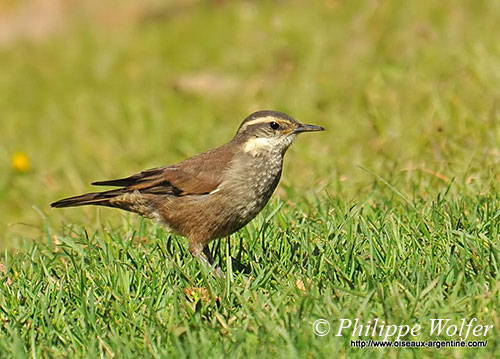
CALLS AND SONGS: SOUNDS BY XENO-CANTO
The call of the Grey-flanked Cinclodes is a dry “tsick”.
The song is a fast, high-pitched trill rising slightly at the end but preceded by 2-3 distinct notes “pip…pip…pip…trweeeeeeeeeeeeeet…”
BEHAVIOUR IN THE WILD:
The Grey-flanked Cinclodes feeds on arthropods and probably takes also several invertebrates. It searches for prey by walking in shallow running water, but it also gleans invertebrates from the surfaces of vegetation, bare earth and rocks. This species forages alone or in pairs. These birds are exclusively diurnal.
The genus “Cinclodes” is usually tied to wetland habitats and their margins.
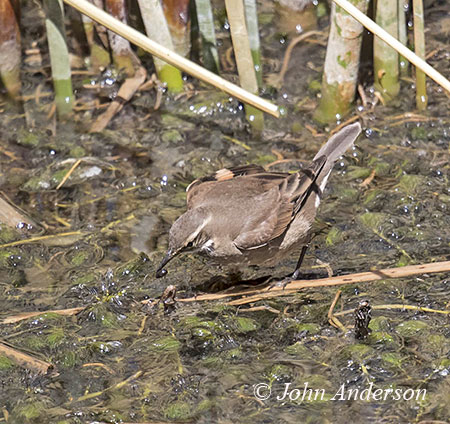
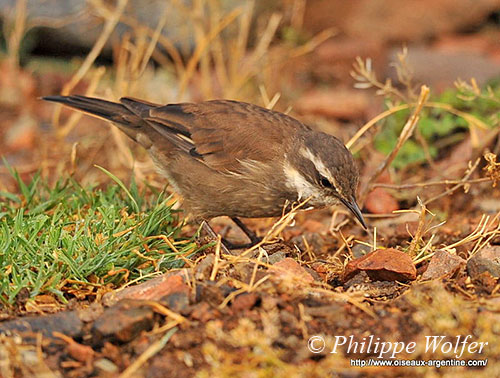
The Grey-flanked Cinclodes is socially monogamous and territorial throughout the year. The pair-bond probably persists outside the breeding season, and possibly for life.
The displays are very poorly known. The wing-raising or wing-flapping display accompanied by song is suspected to be a territorial display. But the conspicuous pale rufous wingbar probably plays a role when the bird opens and raises its wings.
The Grey-flanked Cinclodes nests in burrow in bank, in rock crevice, and often near a stream. Both adults share the nesting duties.
This species is apparently resident, but it may perform some altitudinal movements in winter.
The race C.o. hornensis appears to be partially migratory, with individuals moving north after breeding. They usually reach the south of Argentina and central Chile. They move during the day.
The genus “Cinclodes” includes several species which are excellent fliers.
The subspecies C.o. baeckstroemii occurs on Alejandro Selkirk Island, some 749 km from Biobío region in Central Chile, revealing a capability for crossing substantial barriers to dispersal, including oceans.
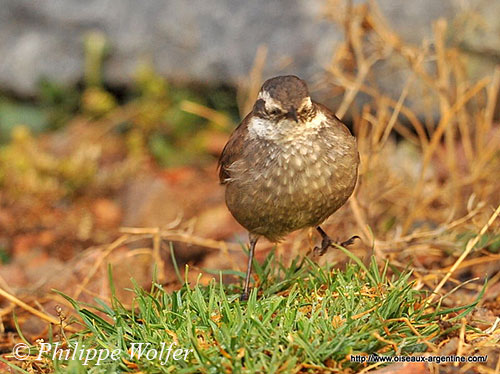
REPRODUCTION OF THIS SPECIES:
The breeding season takes place during the austral spring-summer.
The Grey-flanked Cinclodes is part of the nine species of genus “Cinclodes” known for nesting in natural crevices in rocks, cliffs and even buildings. But they are also known to excavate nest-tunnels, although these tunnels are sometimes abandoned burrows of rodents or other bird species.
However, the Grey-flanked Cinclodes probably excavates its own burrow in earth bank, often near a stream. The nest-chamber is at the end of the tunnel. It is lined with grasses and hair.
The female lays 2-3 white eggs. Both adults share the incubation during two weeks or more. The chicks are fed by both parents and fledge about two weeks after hatching.
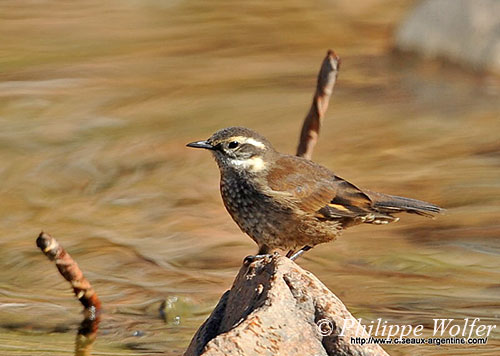
From an observation of the subspecies C.o. baeckstroemii on Alejandro Selkirk Island in Juan Fernández Islands, the species breeds only in natural cavities in rock walls, rocky slopes or ridges. The nest-entrance ranges from 5,5 to 20 cm. The nest-chamber placed within the rock is invisible from the outside. It can be deeper than 25 cm within the rock.
On this island, the nest-sites were located from a little above the sea-level to the summit areas, with a preference for barren canyon bottoms with small streams and humid alpine plateaus.
On Alejandro Selkirk Island, the nesting period extends from early December to late January, indicating a breeding season from November to February.
PROTECTION / THREATS / STATUS:
The Grey-flanked Cinclodes is described as uncommon to fairly common. This species is probably fairly common at high elevations where it inhabits and breeds.
It is affected by habitat degradation caused by some human disturbances and grazing.
The size of the population is unknown, but it is suspected to be declining.
But the Grey-flanked Cinclodes is not considered globally threatened at the moment, and the species is currently evaluated as Least Concern.
